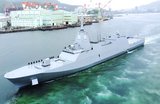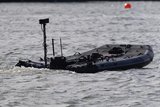HALO programme decommissioned by US Navy in favour of LRASM upgrades
The HALO missile, which proved ultimately too expensive. (Image: Lockheed Martin)
The US Navy (USN) has cancelled its Hypersonic Air-Launched Offensive (HALO) missile development programme.
The HALO programme was developed to create a hypersonic anti-ship missile with a long-distance precision-strike capability. The missile was initially expected to be ready for deployment by 2029, and to be at full operational capability two years later.
The cancellation of the programme was a decision taken in Q4 2024, but the policy shift has just been announced, along with a re-statement of the USN’s commitment to long range anti-ship missile (LRASM) technology.
Shephard asked US Navy spokesperson Captain Ron Flanders why the HALO programme had
Already have an account? Log in
Want to keep reading this article?
More from Naval Warfare
-
![UK to join US Navy’s Virginia-class submarine assembly effort to speed up construction]()
UK to join US Navy’s Virginia-class submarine assembly effort to speed up construction
The expansion of the Virginia-class submarine construction to UK shores could accelerate the project as US shipbuilders continue to fall short of delivery goals.
-
![US Navy seeks new sensors for the CH-53K King Stallion heavy-lift helicopter]()
US Navy seeks new sensors for the CH-53K King Stallion heavy-lift helicopter
The US Navy intends to publish a draft request for proposals in Q2 2026 and conduct an open competition for the supply of new electro-optical and infrared capabilities for the CH-53K heavy-lift helicopter.
-
![What new technologies could be involved in UK Atlantic Bastion initiative?]()
What new technologies could be involved in UK Atlantic Bastion initiative?
As new details emerge on the UK Royal Navy’s plan to secure the North Atlantic for the UK and NATO, three main areas of opportunity for new technology are the focal point.
-
![NATO naval exercises map out future USV requirements but raise questions on acquisition]()
NATO naval exercises map out future USV requirements but raise questions on acquisition
Uncrewed surface vessels have shifted from a desirable capability to a critical one for navies. But should these systems be bought outright, rented as a service or rapidly built using commercial off-the-shelf components?






















